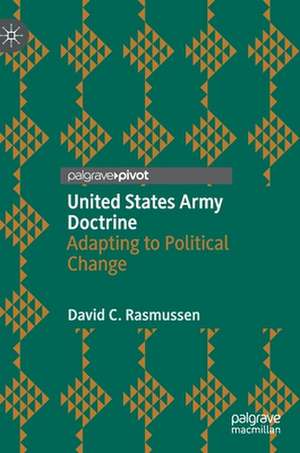United States Army Doctrine: Adapting to Political Change
Autor David C. Rasmussenen Limba Engleză Hardback – 28 iul 2020
| Toate formatele și edițiile | Preț | Express |
|---|---|---|
| Paperback (1) | 368.69 lei 43-57 zile | |
| Springer International Publishing – 29 iul 2021 | 368.69 lei 43-57 zile | |
| Hardback (1) | 373.92 lei 43-57 zile | |
| Springer International Publishing – 28 iul 2020 | 373.92 lei 43-57 zile |
Preț: 373.92 lei
Nou
Puncte Express: 561
Preț estimativ în valută:
71.57€ • 74.59$ • 59.58£
71.57€ • 74.59$ • 59.58£
Carte tipărită la comandă
Livrare economică 06-20 ianuarie 25
Preluare comenzi: 021 569.72.76
Specificații
ISBN-13: 9783030521318
ISBN-10: 3030521311
Pagini: 144
Ilustrații: XI, 144 p. 3 illus.
Dimensiuni: 148 x 210 mm
Greutate: 0.34 kg
Ediția:1st ed. 2020
Editura: Springer International Publishing
Colecția Palgrave Macmillan
Locul publicării:Cham, Switzerland
ISBN-10: 3030521311
Pagini: 144
Ilustrații: XI, 144 p. 3 illus.
Dimensiuni: 148 x 210 mm
Greutate: 0.34 kg
Ediția:1st ed. 2020
Editura: Springer International Publishing
Colecția Palgrave Macmillan
Locul publicării:Cham, Switzerland
Cuprins
Chapter 1. Introduction.- Chapter 2. 1954 Case Study.- Chapter 3. 1962 Case Study.- Chapter 4. 1976 Case Study.- Chapter 5. 2008 Case Study.- Chapter 6. Conclusion.
Notă biografică
Dr. David C. Rasmussen is a retired US Army Infantry Lieutenant Colonel. He earned his PhD in political science from the City University of New York Graduate Center in 2018. He has been a visiting professor for Ashford University, Queens College, and the State University of New York at New Paltz. Dr. Rasmussen currently works as a Department of the Army Civilian planning specialist for the US Army Installation Management Command, in the Garrison Directorate of Plans, Operations, Training, and Security at the US Military Academy, West Point, NY.
Textul de pe ultima copertă
This book argues that the US Army has made four significant shifts in the content of its capstone operations doctrine along a spectrum of war since the end of WWII: 1) in 1954 it made a shift from a doctrine focused almost exclusively on mid-intensity conventional warfare to a doctrine that added significant emphasis to high-intensity nuclear warfare; 2) in 1962 it made an even greater shift in the opposite direction toward low-intensity unconventional warfare doctrine; 3) in 1976 it shifted back to an almost exclusive focus on mid-intensity conventional warfare content; 4) and this is where Army doctrine remained for 32 years until 2008, when it made a doctrinal shift back toward low-intensity unconventional warfare – five and seven years into the wars in Iraq and Afghanistan respectively. Closely tracking each of these shifts, the author zooms in on specific domestic, international and bureaucratic politics that had a direct impact on these shifts.
Dr. DavidC. Rasmussen is a retired US Army Infantry Lieutenant Colonel. He earned his PhD in political science from the City University of New York Graduate Center in 2018. He has been a visiting professor for Ashford University, Queens College, and the State University of New York at New Paltz. Dr. Rasmussen currently works as a Department of the Army Civilian planning specialist for the US Army Installation Management Command, in the Garrison Directorate of Plans, Operations, Training, and Security at the US Military Academy, West Point, NY.
Dr. DavidC. Rasmussen is a retired US Army Infantry Lieutenant Colonel. He earned his PhD in political science from the City University of New York Graduate Center in 2018. He has been a visiting professor for Ashford University, Queens College, and the State University of New York at New Paltz. Dr. Rasmussen currently works as a Department of the Army Civilian planning specialist for the US Army Installation Management Command, in the Garrison Directorate of Plans, Operations, Training, and Security at the US Military Academy, West Point, NY.
Caracteristici
This work examines that impact that domestic, international, and bureaucratic politics had on four significant shifts in United States Army doctrine between 1954 and 2008 This study shows that although the US Army strives to remain largely apolitical as an institution, it cannot completely escape, nor is it completely immune, from the impact of politics An understanding of how politics has impacted the Army in the past, can help Army leaders understand the impact that politics may have in the future
